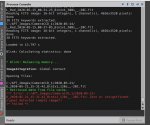Steve Selwood
New member
I have recently purchased an ASI 1600MM-Pro and spent a few nights acquiring some data to process as my dark nights have vanished until late July. I thought all was going well and my light frames were looking good.
I proceeded to take dark frames, flat frames and dark flats (flats darks?) Things started going downhill :-(
When trying to integrate either the dark frames or the flat dark frames I get the following error message "Zero or insignificant signal detected (empty image?)" I have tried to see what is going wrong to no avail. I have followed the settings at 6.1 in https://pixinsight.com/forum/index.php?threads/for-beginners-guide-to-pis-imagecalibration.11547/. Exactly the same error message. Various other threads and Youtube videos following the respective authors setting, exactly the same error. I only get the error with dark frames or flat dark frames. I am able to integrate the light and flat frames with no problems. Thinking I may have inadvertently changed something in PI I tried integrating dark frames from my Nikon D750, no problem all worked perfectly. I am using PI V 1.8.8-5 on Windows 10, I have tried on two different computers but still the same error.
I am now officially stuck and frustrated. I figure I must be doing something wrong but after two days of fiddling taking new dark frames and trying all sorts of permutations I have no ideas left.
In case I am doing something oddly wrong in my dark frame acquisition I have posted the files in dropbox https://www.dropbox.com/sh/y9bpsx6rhje2w4v/AAB5lJxrD8IpcDpdaT0hRU3ba?dl=0
I'd be really grateful if someone could point out to me what stupid mistake I a making, thank you.
I proceeded to take dark frames, flat frames and dark flats (flats darks?) Things started going downhill :-(
When trying to integrate either the dark frames or the flat dark frames I get the following error message "Zero or insignificant signal detected (empty image?)" I have tried to see what is going wrong to no avail. I have followed the settings at 6.1 in https://pixinsight.com/forum/index.php?threads/for-beginners-guide-to-pis-imagecalibration.11547/. Exactly the same error message. Various other threads and Youtube videos following the respective authors setting, exactly the same error. I only get the error with dark frames or flat dark frames. I am able to integrate the light and flat frames with no problems. Thinking I may have inadvertently changed something in PI I tried integrating dark frames from my Nikon D750, no problem all worked perfectly. I am using PI V 1.8.8-5 on Windows 10, I have tried on two different computers but still the same error.
I am now officially stuck and frustrated. I figure I must be doing something wrong but after two days of fiddling taking new dark frames and trying all sorts of permutations I have no ideas left.
In case I am doing something oddly wrong in my dark frame acquisition I have posted the files in dropbox https://www.dropbox.com/sh/y9bpsx6rhje2w4v/AAB5lJxrD8IpcDpdaT0hRU3ba?dl=0
I'd be really grateful if someone could point out to me what stupid mistake I a making, thank you.

